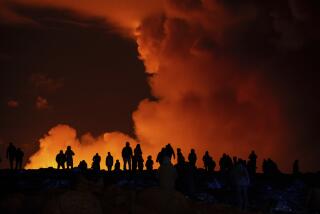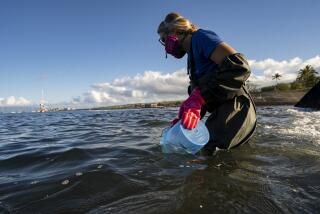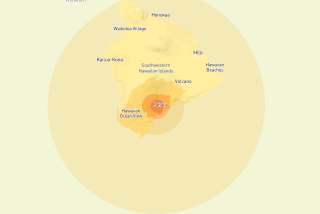The best way to see the volcano on Hawaii Island
We are fascinated by fire. The leap of the flames, the warmth, the danger — fire is both horrifically destructive and spectacularly creative.
On Hawaii Island, home of one of the world’s most active volcanoes, it’s a bit of both.
Kilauea has been erupting since 1983, destroying whole villages and creating new land. About 500 acres have been added to the island since the flow began.
Spending time in the active lava zone and the transfigured area around it is startling and educational. Watching the hot lava pour into the sea, a plume of smoke and steam rising 150 feet, is one of the few times when you can use the word “awesome” without qualms.
Where to begin
The best place to start, if you want to frame your awesome with facts, is Volcanoes National Park on the southern end of the island, where magma makes a name for itself.
The visitor center has historical island information (including eruptive movies), distinctive visual exhibits, a bookstore and rangers quick with answers on all things volcano.
The park encompasses the Jaggar Museum, which has an overlook about a mile from the eruption site of Halemaumau Crater, where steaming lava-lake sightings are a regular feature.
The Jaggar has great exhibits on ancient Hawaiian lore and visuals of Pele’s handiwork as her moods moved mountains.
But my girlfriend, Alice, and I wanted lava more than lore; we wanted to get out and walk on the stuff.
The real thing
A bountiful place for that is the Kilauea Iki Trail, whose trailhead is a quick drive from the visitor center; get a trail guide at the center first.
The trail is a result of a late 1959 eruption that included a 1,900-foot fountain of lava and a lava lake.
You get to walk over the cooled results of that eruption, edge to edge across the crater zone.
Iki is a bizarre landscape of buckled lava, cooled cinder and spatter cones and tiny trees trying to eke out a living.
The eruption denuded the thriving forest that was on the crater floor, which makes the descent from the trailhead above, through the lush rain forest and riotous Hawaiian greenery, all the more dramatic.
The hike is about four miles round trip over rough, bleakly impressive — and occasionally steaming — but not intimidating terrain. The trek will take two to four hours, depending on your lava walking style and whether you packed a lunch as we did.
Before heading back to Hilo, we had strong reviving coffee and sweet desserts at the friendly Lava Rock Café in the nearby little town of Volcano.
Our Hilo home, the comfy Dolphin Bay Hotel, was no slouch when it comes to a vivid landscape of galloping growth, with orchids, fruit trees and gushing creek.
Seeing the hot stuff up close
On Day 2, we wanted to see the hot stuff up close and personal outside the confines of the park.
We first fortified ourselves at the casually gracious Kaleo’s Bar & Grill in Pahoa, about half an hour south of Hilo on Highway 130.
The Mediterranean-plate brunch was outstanding and the town atmosphere funky and loose. A Kilauea flow in late 2014 destroyed several buildings in Pahoa, but that wasn’t visible from the downtown streets.
Follow 130 to the road’s end (don’t take the fork into Kalapana), where you’ll see a parking lot filled with lava enthusiasts.
You can hike for four miles on the gravel road to where the lava flows into the ocean, but we rented bikes from Kaimu Rentals. (Several bike rental options are available near the lava viewing.)
Biking to the flow is surreal: The landscape is blasted and buckled, with sinuous twists and torquings of the topography. Then, in this moonscape, you see the occasional small house, with a driveway, perhaps some adjacent plants, made dramatic by the severity of the surroundings.
The biking road is rough and modestly hilly, but it’s not an overly strenuous ride. We parked about half a mile from the viewing area, heading off on foot over bumpy lava to see nature’s barbecue.
The lava viewing is a roll of the dice: Vents and crevices open, flow and cool constantly, so your lava encounter changes day to day.
We followed a protective rope line to where we could see a luminous lava “skylight,” perhaps 10 feet wide, a few feet tall and glowing like the eyes of Satan’s cat.
People do make these tours in the evening as well, where the lava glows are more dramatic, but the footing getting there demands more attention.
Reversing course, we hiked back to where the cliff curved and the lava poured its flame into the ocean.
Wow.
Crashing waves, giant steam, gas plumes and the powerful sense that nature knows things you don’t. Along with a small crowd, we stared, mostly in silence. Awesome indeed.
If you go
THE BEST WAY TO HAWAII ISLAND
From LAX, United offers nonstop service to Hilo, and United, Delta, Hawaiian, American and Virgin America offer connecting service (change of planes). Restricted round-trips fares from $712, including taxes and fees. American, Delta and United offer nonstop service to Kailua Kona, and United, Delta, Hawaiian, American and Alaska offer connecting service (change of planes). Restricted round-trip fares from $650, including taxes and fees.
WHAT TO DO
Hawaii Volcanoes National Park $20 vehicle fee; $10 for pedestrians or bicyclists
Kaimu Bike Rentals, Highway 130, Kalapana, Hawaii; (808) 333-4392
WHERE TO STAY
Dolphin Bay Hotel, 333 Iliahi St., Hilo, Hawaii; (877) 935-1466. Rooms from $109.
WHERE TO EAT
Lava Rock Café, 19-3972 Old Volcano Road, Volcano, Hawaii; (808) 967-8526
Kaleo’s Bar & Grill, 15-2969 Pahoa Village Road, Pahoa, Hawaii; (808) 965-5600
Kalapana Farmers Market. If you ride to the lava on a Wednesday, you can go to the Kalapana Farmers Market that evening. The market resembles a love-in from yesteryear, with hippies, organic foods, arts and crafts, music and kava bars.
TO LEARN MORE
Island of Hawaii Visitors Bureau
travel@latimes.com
@latimestravel
More to Read
Sign up for The Wild
We’ll help you find the best places to hike, bike and run, as well as the perfect silent spots for meditation and yoga.
You may occasionally receive promotional content from the Los Angeles Times.






